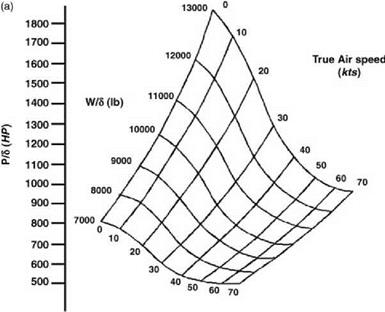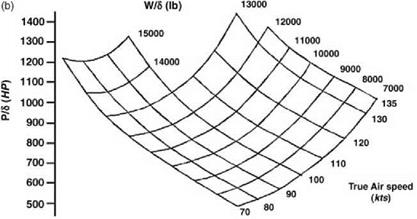Climb in Forward Flight
As a first approximation let us assume that for climbing flight the profile power and parasite power remain the same as in level flight and only the induced power has to be reassessed.
|
|
|
Figure 7.4 (a) Power carpet for rapid calculation (low speed). (b) Power carpet for rapid calculation (high speed) |
The forced downflow alleviates the Vi term but the climb work term, TVC, must be added. In coefficient form the full power equation is now:
1 1 f
Cp = kiliCT + Cd0S [1 + km2] + rm3 + IcCt (7-12)
8 2 A
The usual condition for calculating climb performance is that of minimum power forward speed. In this flight regime, Vi is small compared with V, its variation from level flight to climb
can be neglected and the incremental power DP required for climb is simply TVC. Thus the rate of climb is given by:
|
|
The result is a useful approximation but requires qualification on the grounds that since climbing increases the effective nose-down attitude of the fuselage, the parasite drag may be somewhat higher than in level flight. Also, because the main rotor torque is increased in climb – Equation 7.12- an increase in tail rotor power is needed to balance it. Some of the incremental power available is absorbed in overcoming these increases and hence the climb rate potential is reduced, perhaps by as much as 30%. A further effect is that the increase in drag moves the best climb speed to a somewhat lower value than the level flight minimum power speed.
For a given aircraft weight, the incremental power available for climb decreases with increasing altitude, mainly because of a decrease in the engine performance characteristics. When the incremental power runs out at best climb speed the aircraft has reached its absolute ceiling at that weight. In practice, as Equation 7.13 shows, the absolute ceiling can only be approached asymptotically and it is normal to define instead a service ceiling as the height at which the rate of climb has dropped to a stated low value, usually about 0.5 m/s (100 ft/min). Increasing the weight increases the power required at all forward speeds and thereby lowers the ceiling.













